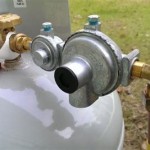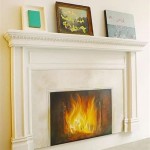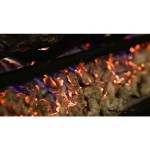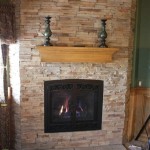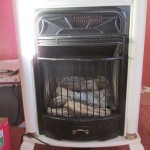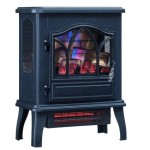What Can You Cover a Brick Fireplace With?
Brick fireplaces, while often possessing a certain rustic charm, can sometimes clash with a homeowner's evolving aesthetic preferences. Whether the brick is outdated in color, damaged, or simply doesn't align with a more contemporary design, covering it offers a relatively straightforward way to update a room's appearance. However, selecting the right material to cover a brick fireplace requires careful consideration of several factors, including budget, desired style, installation complexity, and the fireplace's functionality. This article will explore several popular options for covering a brick fireplace, detailing their advantages, disadvantages, and key considerations for a successful project.
Before starting any fireplace renovation, it is crucial to ensure the underlying brick structure is sound and in good repair. Any cracks, loose bricks, or water damage should be addressed before applying any covering material. Ignoring these issues can lead to further deterioration and potentially compromise the integrity of the new fireplace façade. Furthermore, consider the fireplace's functionality. If it is a working fireplace, heat-resistant materials are essential to ensure safety and prevent potential fire hazards.
Paint: A Cost-Effective and Versatile Solution
Painting brick is arguably the simplest and most affordable option for altering its appearance. It allows for a complete color transformation and can be customized to match any interior design scheme. The key to a successful paint job lies in proper preparation and the selection of the right type of paint.
The preparation process involves thoroughly cleaning the brick surface to remove any dirt, soot, or grease. A wire brush can be used to scrub away loose debris, followed by a cleaning solution specifically designed for brick. Once the brick is clean and dry, applying a primer is essential. A masonry primer helps to seal the porous surface of the brick, creating a consistent base for the paint and improving adhesion. Without primer, the paint may soak into the brick unevenly, resulting in a blotchy or inconsistent finish.
Choosing the right paint is equally important. Latex paint, specifically designed for masonry, is generally recommended. It is breathable, allowing moisture to escape from the brick, which helps prevent cracking and peeling. Oil-based paints, while durable, are less breathable and can trap moisture, potentially leading to damage over time. For working fireplaces, high-heat paint should be used around the firebox opening to withstand the extreme temperatures. Consider applying multiple thin coats rather than one thick coat for a more even and durable finish.
While painting is a relatively easy DIY project, it's important to understand its limitations. Painted brick can be difficult to reverse, and the paint may require periodic touch-ups to maintain its appearance. Additionally, painting will not alter the texture of the brick, so any existing imperfections will still be visible.
Stone Veneer: Adding Texture and Elegance
Stone veneer offers a more substantial and luxurious alternative to paint. It provides a realistic stone appearance without the weight and expense of full-thickness stone. Stone veneer is available in a wide variety of styles, colors, and textures, allowing homeowners to achieve a range of aesthetic looks, from rustic to contemporary.
Unlike paint, installing stone veneer is a more complex project that may require professional assistance. The process typically involves applying a mortar base to the brick surface, followed by carefully adhering the individual stone veneer pieces. Proper spacing and alignment are crucial for achieving a visually appealing and structurally sound installation. Because veneer is heavier, it is important to ensure proper support through fasteners and mortar.
One of the significant advantages of stone veneer is its durability and longevity. It is resistant to fading, chipping, and cracking, making it a low-maintenance option for covering a brick fireplace. Furthermore, stone veneer can add insulation value to the fireplace, helping to improve energy efficiency. However, it is a more expensive option than paint, and the installation process can be time-consuming and labor-intensive.
When selecting stone veneer for a working fireplace, consider the heat resistance of the material used. Some veneer products can be susceptible to damage from high heat or can be flammable. Consult the manufacturer's specifications to ensure the chosen veneer is suitable for use around a functioning fireplace. Additionally, ensure that the mortar used is specifically designed for high-heat applications.
Tile: A Versatile and Durable Covering
Tile is another popular option for covering a brick fireplace, offering a wide range of design possibilities. From classic ceramic tiles to modern glass or porcelain tiles, the choices are virtually endless. Tile is also highly durable and easy to clean, making it an ideal choice for high-traffic areas.
Similar to stone veneer, installing tile requires a mortar base and careful attention to detail. The process involves applying thin-set mortar to the brick surface and then setting the tiles in place, ensuring proper spacing and alignment. Grouting the tiles is the final step, which involves filling the spaces between the tiles with grout and cleaning away any excess. This binds the tile and prevents moisture penetration and damage.
Tile offers several advantages over other covering materials. It is highly resistant to heat, making it suitable for use around working fireplaces. It is also available in a wide range of colors, sizes, and styles, allowing for complete customization. Furthermore, tile is relatively easy to clean and maintain, requiring only occasional wiping with a damp cloth. For working fireplaces, heat-resistant grout is recommended.
The cost of tiling a fireplace can vary depending on the type of tile selected and the complexity of the installation. High-end tiles can be significantly more expensive than basic ceramic tiles, and intricate designs may require professional installation, adding to the overall cost. Additionally, the weight of tile must be considered. Ensure the fireplace structure is adequately reinforced if using heavy tile and mortar.
Wood: Achieving a Rustic or Modern Aesthetic
Wood can offer a warm and inviting aesthetic to a fireplace, adding a natural and rustic touch to the room. It can be used in various forms, including shiplap, wood panels, or even reclaimed wood, to create a unique and personalized look. Wood can also lend itself to modern designs through clean lines and geometric patterns.
Installing wood over brick typically involves attaching furring strips to the brick surface and then securing the wood panels or boards to the furring strips. This creates a level surface for the wood and allows for proper ventilation. When installing wood around a working fireplace, it is crucial to adhere to strict safety guidelines to prevent fire hazards.
One of the primary concerns when using wood around a fireplace is its combustibility. Wood is highly flammable and can pose a significant fire risk if not properly installed and protected. It is essential to maintain a safe distance between the wood and the firebox opening and to use non-combustible materials like cement board around the firebox to protect the surrounding wood. Often using the wood as a mantle is the safest approach.
Consider using fire-retardant treated wood to reduce the risk of fire. This type of wood has been chemically treated to resist ignition and slow the spread of flames. Regular inspections are necessary and cleaning of soot and debris is important. Additionally, applying a fire-resistant coating to the wood surface can provide an extra layer of protection.
Wood can add a touch of warmth and character to a fireplace, but it is important to prioritize safety and follow all building codes and regulations to prevent fire hazards. Consult with a qualified contractor or fire safety expert to ensure a safe and compliant installation.
In summary, homeowners have a diverse range of options for covering a brick fireplace, each offering unique aesthetic qualities and practical considerations. The choice of material should be based on individual preferences, budget constraints, and the intended use of the fireplace. Proper preparation, installation, and adherence to safety guidelines are essential for ensuring a successful and long-lasting renovation.

How To Cover A Brick Fireplace With Wood Stone Nina Hendrick Home Remodel Diy

How To Cover A Brick Fireplace With Wood Stone Nina Hendrick Home

How To Plaster A Brick Fireplace So Much Better With Age

How To Cover A Brick Fireplace With Stone

How To Cover A Brick Fireplace With Wood Stone Nina Hendrick Home

16 Red Brick Fireplace Makeover Ideas
:max_bytes(150000):strip_icc()/MadetobeaMommaBefore-5bb2476446e0fb002607ad4f.jpg?strip=all)
Before And After Fireplace Makeovers

Brick Fireplace Makeover Pine And Prospect Home

Diy Fireplace Makeover Wood Slat

How To Cover A Brick Fireplace With Wood Stone Nina Hendrick Home
Related Posts


